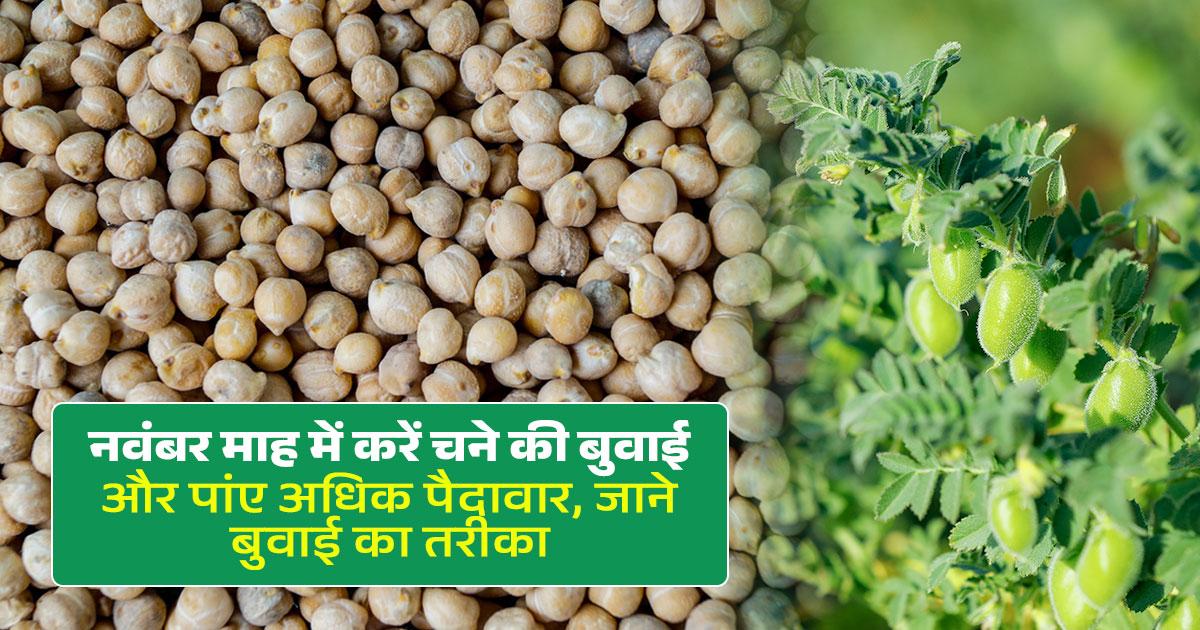
Chickpea (gram) is a key Rabi crop cultivated extensively across various regions of India. It plays a crucial role in making India self-reliant in pulse production. Chickpeas are rich in protein, carbohydrates, and fat, with good amounts of calcium and iron. Additionally, chickpeas are used for medicinal purposes such as blood purification and treatment of other ailments. Chickpeas account for approximately 45% of the total pulse production in India.
Chickpea is a Rabi season crop that thrives in low-rainfall regions with better quality and yield. The ideal temperature for chickpea cultivation is between 24°C to 30°C. The crop is sensitive to moisture, and excess moisture can reduce yield. Chickpeas grow well in loamy to deep black soils. Sandy soils with good drainage are also suitable. The ideal soil pH range for chickpea cultivation is 6.0 to 7.5.
Water Requirements for Chickpea: Chickpea crops require 600–900 mm of water throughout their lifecycle. Overwatering, particularly during sowing, flowering, and seed formation stages, can harm the crop.
Field Preparation: The field should be plowed 1–2 times depending on soil conditions. Add 2–3 tons of farmyard manure (FYM) mixed with compost bacteria to the soil. Let the mixture decompose in the open field for two weeks. Use a rotavator to blend the manure into the soil, ensuring proper leveling.
When to Sow Chickpeas: Sow chickpeas by the second week of October. In cases where sowing is delayed due to the late harvest of paddy, chickpeas can be sown between mid-November and December.
How to Sow Chickpeas: Chickpeas should be sown using a seed drill under moist conditions. If the soil lacks moisture, sow seeds deeper and compact the soil using a plank. Maintain a plant population of 25–30 per square meter, with row spacing of 25–30 cm and plant spacing of 8–10 cm. For irrigated Kabuli chickpeas, maintain a spacing of 40–45 cm between rows.
Irrigation for Chickpea: Chickpea cultivation requires minimal water. Irrigate the field 2–3 times during the crop lifecycle, particularly 45 days and 70 days after sowing. Pre-sowing irrigation is essential for better seed germination. Use a sprinkler system to irrigate the crop for about three hours.
Fertilizers for Chickpea: Apply fertilizers based on soil testing results. To achieve higher yields, use 20–25 kg nitrogen, 50–60 kg phosphorus, 20 kg potash, and 20 kg sulfur per hectare.
Major Diseases and Their Control: Wilt Disease: Wilt is a significant disease in chickpea cultivation. Symptoms appear from 30 days after sowing to the pod formation stage, causing plants to wilt and roots to develop dark streaks.
Control Measures: Opt for resistant varieties like Desi Chickpea: JG 315, JG 322, JG 74, JG 130; Kabuli Chickpea: JGK 1, JGK 5.
Sow chickpeas between late October and early November.
Major Pests and Their Management: Pod Borer: This pest reduces chickpea productivity by 20–30%. Pod borers lay eggs on leaves, and larvae bore into pods, consuming the seeds.
Control Measures: Use pheromone traps for early pest detection. Conduct deep summer plowing to destroy larvae.
Intercropping for Chickpea: Intercrop chickpeas with coriander, mustard, or flaxseed by planting 1–2 rows of these crops after every 10 rows of chickpea. This practice reduces pest infestation and attracts beneficial insects.